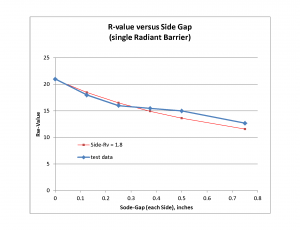Perhaps the most pleasant surprise was the very high Rw-Value of shades made from two layers of radiant-barrier material separated by a one-inch air gap. Tests were made of various air-gap dimensions and the common wisdom of 3/4″ to 1″ gap was confirmed as the optimum. The air between the two sheets becomes useful as insulation, but the gap is narrow enough that convection currents do not become dominant.
Even better results were found when horizontal films of plastic were included across the unit every inch. This further inhibited the tendency of convection currents to form between the sheets. This would indicate the usefulness of cellular shades to reduce heat flow, but tests did not bear this out, probably because the captured air gap in these is typically much less than the optimum 3/4-1″.
The effect of side-gaps was tested using a shade of radiant-barrier material. Because it had a relatively high Rw-value it acdentuated the negative affects of the gaps. Side-gaps were tested from 1/8″ to 3/4″..
A common belief has been that gaps around window shades or insulation were very bad. Testing with the old system was done to check this. Yes, gaps at the bottom of a shade are very bad, as they allow convection currents between the bottom and the side gaps, basically encouraging the “chimney effect”. But the side-gap effect for those with no bottom gap was reasonably low. While small side-gaps (1/8″) caused a drop of 15% in Rw-value, even large gaps of 1/2″ on each side caused less than 30% drop.
These gaps can be modeled as independent Rw-Values (although in reality they are likely more convection related). The effective Rw-value can be calculated from the value with no gap, and the value with the gas (using the know gap area), Remember that an R-value of zero is infinite heat flow. The effective Rw of the air gap was found to be about 1.8. This gives a reasonable approximation to the test data (red line on graph below). While this is incorrect by the same ratio as all the Rw-values (probably 2+) it is still comparable to a single pane window. In the more practical case of a double sheet shade the value would likely be much higher since the delta Ts are reduced and there is less room for convection currents.
When treated as an equivalent Rw-value the effect of gaps can be applied to any window. This is one purpose of the standardized test, to tease apart the variables so they can be applied to any window.
Notice the size of the Rw-value (15-21) based on the old design. The real value is probably half of that.
I built a full-sized shade (3′ high by 6′ wide) based on the double-surfaced radiant barrier results. Even without tight fitting side-seals (gaps of about 1/8 to 1/4 inch) this shade has an R-value better than the walls of my cinder-block house based in inside wall temperatures.
